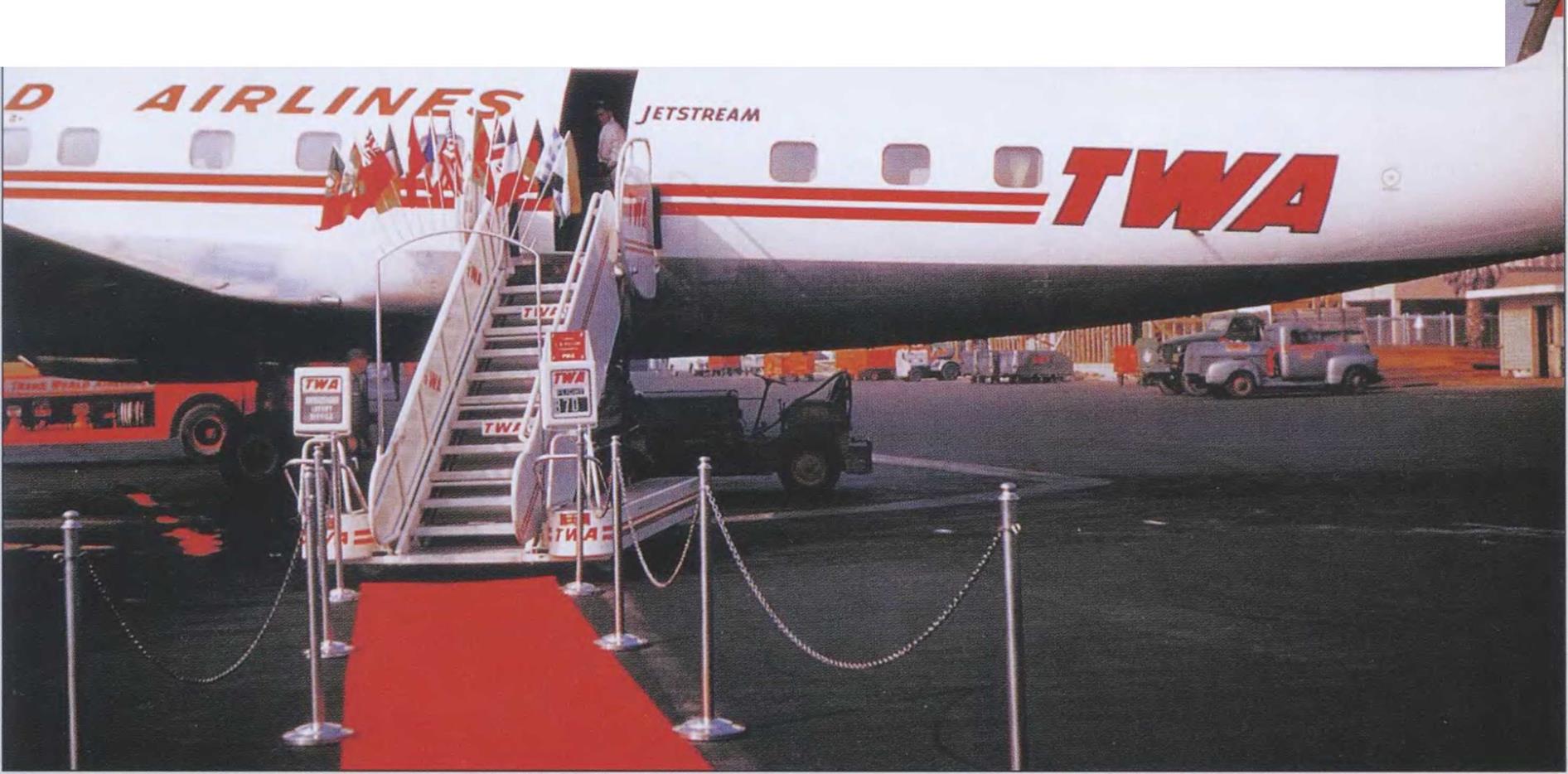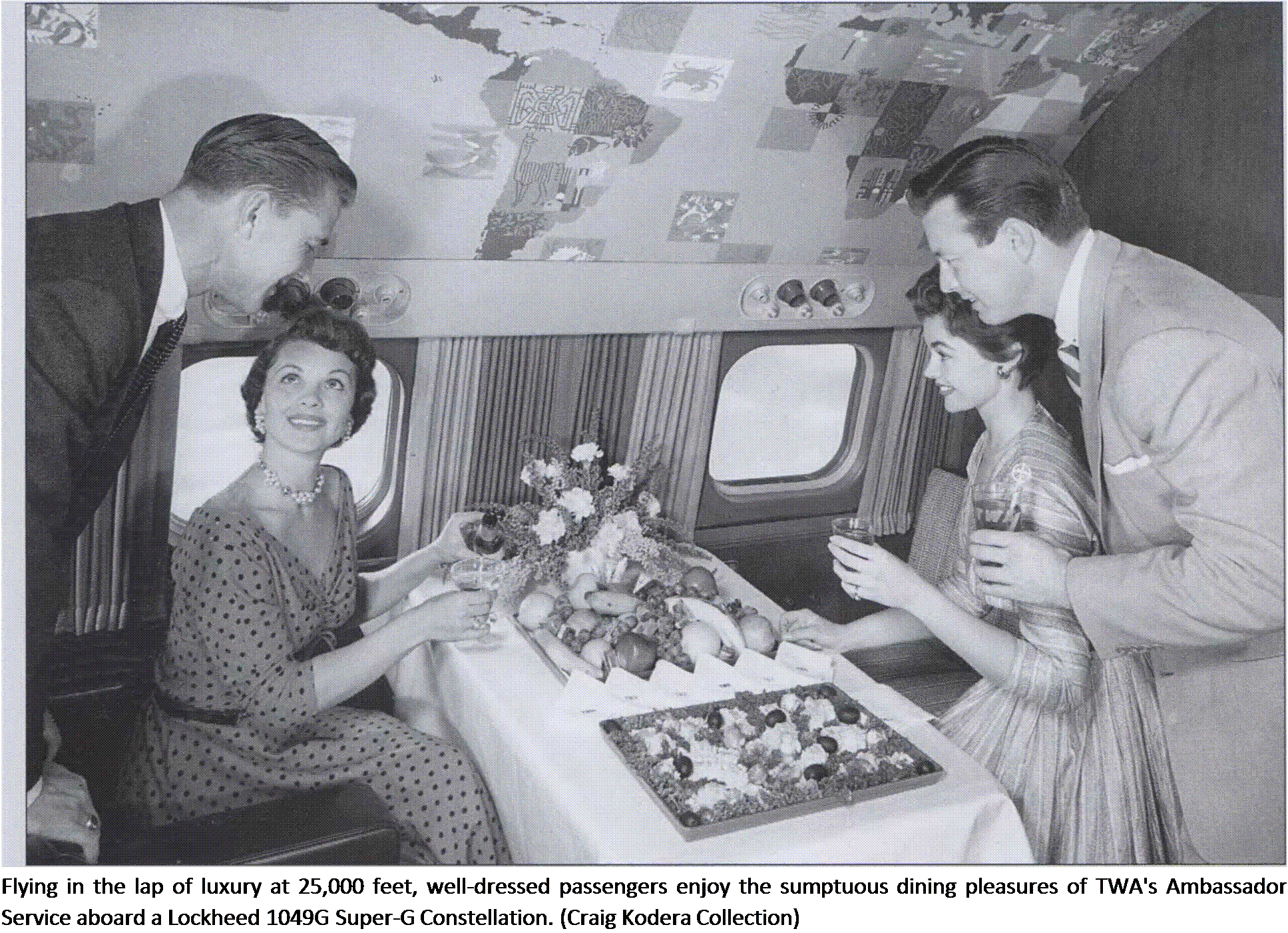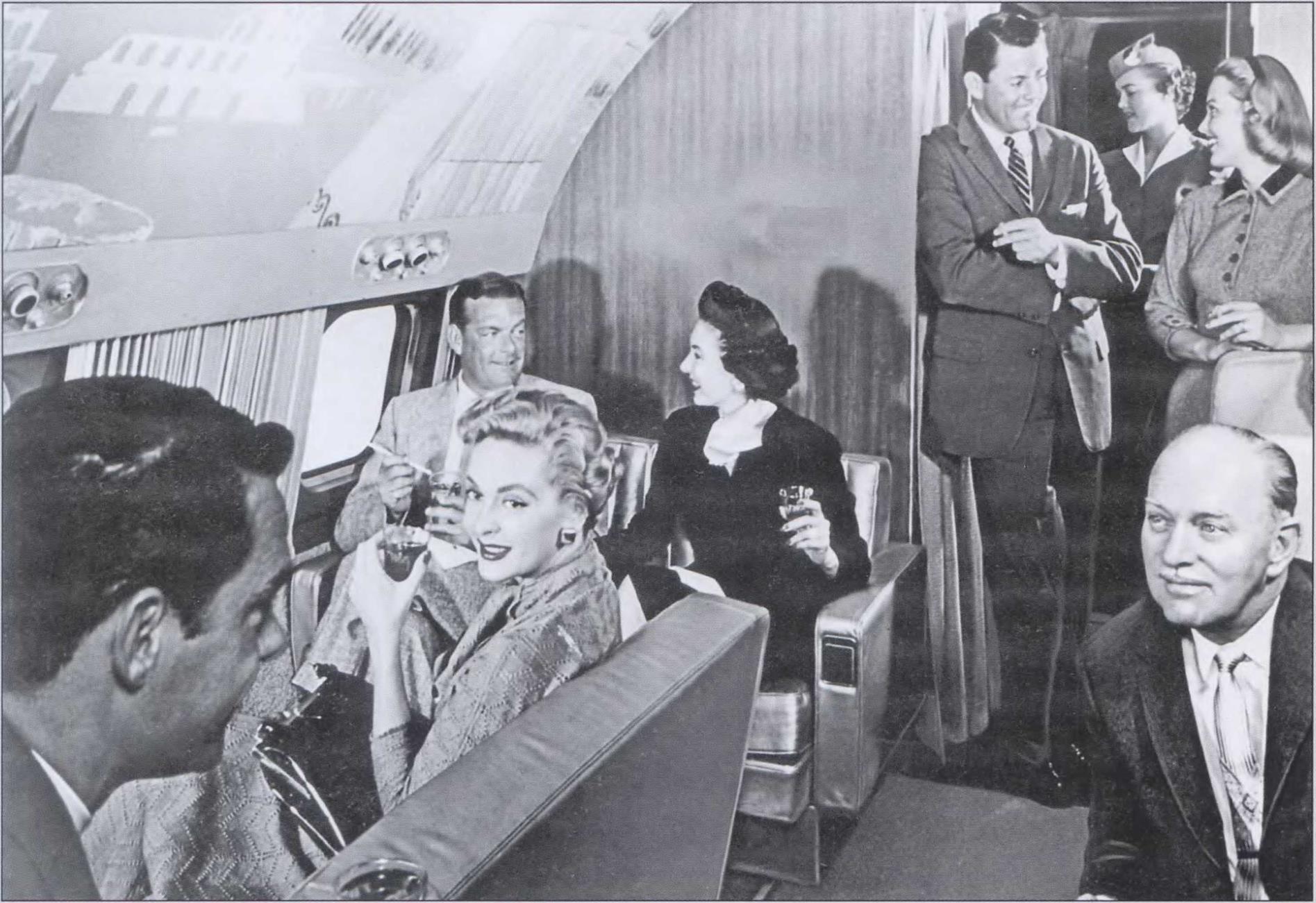TRAVELING IN STYLE
TWAJs AMBASSADOR SERVICE
■
|

|
F |
aced with serious postwar competition from irregular, non-scheduled airlines, U. S. trunk carriers struck back with what became known as “tourist” or “coach” service, implemented using higher-density seating or standard-configuration airplanes at off – peak hours; what many purists considered the beginning of the end of civilized air travel. Most of these flights featured boxed meals available for purchase in the airport terminal before boarding, multiple en-route stops, and long rides in cramped cabins.
Sleeping berths, a more common feature on prewar aircraft, began to disappear with the advent of faster, four-engine equipment. In the United States, American Airlines and TWA retained berths on new DC-6s and Constellations for added comfort on longer domestic segments, as did United for its Hawaii service. But gradually, sleeping accommoda
tions were removed from the Douglas types. Meanwhile, TWA’s transatlantic routes justified the berths and gave it an advantage on its longest flights within North America. At the same time, airline managers recognized the demand for premium service above and beyond standard first class.
In 1948, just a year before TWA began offering Sky Coach flights within the United States, the airline took its transatlantic service to a higher level by introducing weekly, all-sleeper “Paris Sky Chief” flights between New York and Paris with a scheduled stop at Gander; westbound, it became the “New York Sky Chief.” Limited to only 18 passengers, the cabin layout included a cocktail lounge in the forward section of the main cabin. Advertisements spoke of champagne dinners and a pre-arrival hot breakfast “served in bed, if you prefer!” With the delivery of longer-range

749A Connies, TWA moved these trips from LaGuardia to the newer Idlewild Airport with its longer runways, beginning nonstop flights in November 1951, although weather conditions still dictated occasional en-route landings for fuel.
The upgraded flights became known as Paris and New York “International Ambassador Service,” while the Sky Chief name was reassigned to domestic first – class segments. A similar service was initiated with TWA’s new New York-to-London route, and sleeper flights were increased to twice-weekly frequencies.
The Ambassador name was carried over to domestic service with TWAs introduction of 1049 Super Constellations, referred to as “Ambassador Service in the U. S.” Although restricted to domestic flights, the 64-seat, all-first-class Super Connie cabins were equipped with eight convertible berths for use on night flights. A fold-down table in the “cozy” seven-seat lounge provided space for an elaborate snack buffet presentation.
Ambassador Service was greatly enhanced with the introduction of 1049G Super G Constellations in
September 1956, the first dual-class aircraft in the United States. Passengers seated in the noisier forward cabin received “Golden Banner Deluxe Coach Service” that featured hot meals for purchase, along with cocktails for sale. Meanwhile, a limited number of sleeping berths were available for Ambassador customers on night flights. In the more spacious midcabin “Mural Lounge,” canapes were offered from a silver serving tray, along with cocktails before an elaborate meal service with wine and champagne.
The ultimate Ambassador Service was offered aboard TWA’s Model 1649A Starliners, which were referred to as “Jetstreams,” a reference to the fact that the airplane could take advantage of high-altitude jet – stream winds, although the clever deception came from the reference to jets that were yet to arrive. TWA even featured illustrations of the airplane in its advertising, sans propellers, a tactic discontinued after a storm of protests from competing airlines. This airplane, often referred to as the “Cadillac” of the Constellation series, entered service with TWA in June 1957 on transatlantic and longer domestic routes.
The airline’s 1649As were furnished with “Siesta Sleeper Seats,” perhaps the most comfortable on any airliner at the time. With pull-out footrests and deep seatback recline, the chairs were nearly as comfortable as the sleeper berths that were also available, and provided a competitive edge, both on transatlantic and transcontinental segments. In the Mural Lounges, each 1649A featured a different colorful Marie Zamparelli wall painting representing major cities and nations served by TWA.
Perhaps the Jetstream’s greatest asset was its ability to provide reliable nonstop flights across the Atlantic in both directions, even from southern Europe. Its range was sufficient enough to allow TWA to begin nonstop flights between U. S. West Coast cities and Europe via the polar route. And while Super G Connies and DC-7s struggled to complete westbound nonstop routes across the country against heavy winter winds, the Jetstream flew these segments with ease.
The Ambassador moniker gave way to TWA’s “Royal Ambassador Service” in June 1961, aboard Boeing 707s across the Atlantic. Perhaps the ultimate
first-class experience at the time, it was limited to just 20 passengers and began with hand luggage delivered to the passenger’s reserved seat. A choice of seven dinner entrees included Chateaubriand carved on an aisle cart, part of a multi-course, 2Z-hour meal presentation. “R/A Service,” as it was known within the airline industry, was later expanded to long-haul domestic flights and became the envy of competing airlines for the rest of the decade.
In April 1970, TWA resurrected the Ambassador Service trademark as part of a complete makeover of its Boeing 707 and Convair 880 cabin interiors to more closely match the 747s that began joining the fleet earlier in the year. The identity, which extended to both first class and coach, later expanded to the airline’s 727s as well.
Although the “new” Ambassador Service was well received, it could not match the individualized attention that cabin crews were able to give their customers on the longer flights of the pre-jet era, when there was time for leisurely meals, making up sleeping berths, and offering passengers breakfast in bed.
|



![]()
![]()

Г/Л. . — — ~»-ТГУ»
…••«•••• •* *
Мм, ■ ч – ».–•• . _ . і.» *r -/«Дінма
и»-— • ••••••
• •■•rv. e * .t—
t/*:* •«•••’ – . • • ••• ijJg
– ..••• . * • • , • •• • ^
■*.» • * « . • • я
* •• »., .•**■•••••. • . • . . • •• **£
—• ■«• – – – 4 ***"•»•• • • • – .,»»
• -. • • •. – • – – ^ « * * * • * Л Д л.»v *
y4 ………. … • # • – – – —?>>
• •••** •**. »• • • . **•» и». > ^ ;, • – • • жгавг’
1.
..*• . • ‘•••«••»* % ‘ . —-
* *ЧМ*’ • • *• **♦ • . ••* • •*** • * r.- ’tl
f.. ……… i4 ‘ *5
S. tS*;•■•■•4 . ~ • • -•
•• M* • ‘ * « V • .
* * * L *. .■ * * * ■ , e • • v. * ’ *
* – M ГГ U. *, • *V-s.»■ –
■ І ї?7м і ‘ § Ш " 9 **• • * ,
• w, «,#• .f * *•; 4»..« .
 |
|
|
|
|
|
|
|
|

|
T |
he age of turbine-powered commercial aircraft officially begins with new foreign-built turboprop regional airliners replacing the stalwart piston-powered transports of the time. Although the world’s first – generation jetliners are making their appearance, they are still months away from certification for passenger use. The airline industry is preparing for an impending change as the world awaits the beginning of an exciting new era in travel.
"Jet Powered"
If you lived in Small Town, USA, in 1958 and were worried that the jet revolution would pass you by, you shouldn’t have been. The local service carriers that supported such cities with airline service had a big surprise for customers, with airplanes like the twin-turboprop Fairchild F-27. Whether for business or family trips, the wonder of turbine aviation in the late-1950s was a
breath of fresh air for communities with travelers tired and beat-up from flying on what seemed like “ancient,” stuffy, old DC-3s. On route segments to larger cities, the four-engine Vickers Viscount brought turbine – powered flight to modern commercial aviation, and the Bristol Britannia ruled the transoceanic skies.
Turboprops were exciting: the sounds, the smell of kerosene, the speed. There was an overall impressiveness












